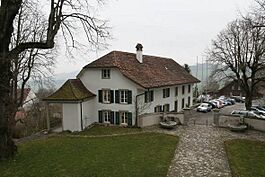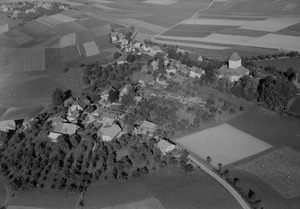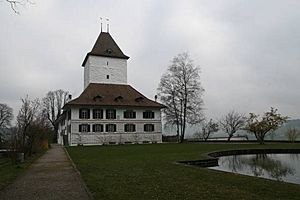Schlosswil facts for kids
Quick facts for kids
Schlosswil
|
||
|---|---|---|

The Amtshaus of Wil Castle
|
||
|
||
| Country | Switzerland | |
| Canton | Bern | |
| District | Bern-Mittelland | |
| Area | ||
| • Total | 3.5 km2 (1.4 sq mi) | |
| Elevation | 753 m (2,470 ft) | |
| Population
(Dec 2011)
|
||
| • Total | 645 | |
| • Density | 184.3/km2 (477/sq mi) | |
| Postal code |
3082
|
|
| Surrounded by | Biglen, Grosshöchstetten, Konolfingen, Trimstein, Worb | |
Schlosswil is a former town in the Bern-Mittelland area in the region of Bern in Switzerland. On January 1, 2018, Schlosswil joined with the town of Grosshöchstetten.
Contents
History of Schlosswil
Schlosswil was first mentioned in records way back in 1146. Back then, it was called Wilare. Later, until 1902, it was known as Wyl.
Early Settlements and the Castle
People have lived in this area for a very long time. We know this because Bronze Age tools and old carved granite blocks have been found here. Some items from the Roman times were also discovered near a street called Schlossallee.
During the Middle Ages, a strong fort, known as Burg Wil, was built near the village. This fort became the center of the Herrschaft of Schlosswil. A Herrschaft was like a small territory ruled by a lord. The first lords of this fort were called the Freiherren von Wiler, and they were mentioned in 1146.
Around the year 1300, the von Wiler family ended. The village and its land then passed to several other noble families. These included the Freiherren von Signau and later the Senn von Münsingen family. The land was even split in half for a while! But in 1514, a person named Burkhard von Erlach brought the two halves back together.
Castle Rebuilding and Changes
Sadly, the medieval castle was destroyed by a fire in 1546. But it was quickly rebuilt as an even bigger castle! A master builder named Niklaus von Wattenwyl-May led this project. The castle you see today looks mostly like it did after a big renovation in 1780. That's when it got its fancy Baroque style on the outside. These noble families continued to rule the village until 1798.
Village Church and Modern Times
The village church, dedicated to St. Germanus, was first mentioned in 1239. The building we see now was built in 1660.
For a long time, until 2010, the Konolfingen District was managed from the castle in Schlosswil. This district office was a big employer for the town. However, most people who live in Schlosswil travel to work in bigger cities like Bern or Thun.
Geography of Schlosswil
Schlosswil covers an area of about 3.5 square kilometers. A large part of this land, about 70.7%, is used for farming. About 20.9% of the area is covered by forests. The remaining 9.0% is used for buildings and roads.
Most of the farming land is used for growing crops. The forests are mostly dense woods, with some smaller groups of trees or orchards.
Location and Settlements
The town is located between two river valleys: the Aare and the Emme. Schlosswil includes the main village, a settlement called Thali, and smaller hamlets like Öli, Weiergut, and Untere Mühle. Until 1980, the nearby town of Oberhünigen was also part of Schlosswil.
On January 1, 2010, Schlosswil became part of the new Bern-Mittelland administration area.
Schlosswil's Coat of Arms
The blazon of Schlosswil's coat of arms is described as Bendy of four Azure and Or. This means it has four diagonal stripes, alternating between blue (Azure) and gold (Or).
People of Schlosswil
As of 2010, about 2.7% of the people living in Schlosswil were from other countries. Over the past ten years, the population has changed a little, mostly due to people moving in or out.
Languages Spoken
Most people in Schlosswil, about 97.4%, speak German as their main language. The second most common language is Serbo-Croatian, and a few people also speak French.
Population Details
In 2008, the population was almost evenly split between males (50.5%) and females (49.5%). Most people living in Schlosswil were born in Switzerland. About 29% were born right in Schlosswil, and over half were born in the same canton (Bern).
In 2011, children and teenagers (up to 19 years old) made up about 21.4% of the population. Adults (20-64 years old) made up 61.9%, and seniors (over 64) made up 16.7%.
Homes and Households
In 2010, there were 61 households where only one person lived. There were also 21 households with five or more people. Most apartments in Schlosswil are lived in all the time.
The chart below shows how the population of Schlosswil has changed over many years:

Important Heritage Sites
The Castle and its beautiful park are considered a very important heritage site in Switzerland. This means they are protected because of their historical and cultural value.
Economy and Jobs
In 2011, Schlosswil had a very low unemployment rate, meaning almost everyone who wanted a job had one. In 2008, there were 197 people working in the town.
Types of Jobs
- Farming: About 62 people worked in the primary sector, which mostly means farming. There were 21 businesses related to farming.
- Manufacturing and Building: About 20 people worked in the secondary sector, which includes things like manufacturing and construction. There were 5 businesses in this area.
- Services: The largest group, 115 people, worked in the tertiary sector, which includes services like shops, restaurants, and offices. There were 17 businesses in this sector.
Many people who live in Schlosswil travel to other towns for work. In 2000, about 291 people left Schlosswil for their jobs, while only 88 came into the town to work. Most people (58.7%) used a private car to get to work, while 13.8% used public transportation.
Education in Schlosswil
Education is important in Schlosswil. About 44.8% of the people have finished high school, and 13.1% have gone on to higher education, like university.
School System
The Canton of Bern has a specific school system:
- One year of non-required Kindergarten.
- Six years of Primary school.
- Three years of required lower Secondary school, where students are grouped by their abilities.
After lower Secondary school, students can continue their education or start an apprenticeship (learning a trade on the job).
During the 2011–12 school year, 74 students attended classes in Schlosswil. There was one kindergarten class with 20 students. The town had two primary classes with 40 students. There was also one lower secondary class with 14 students.
In 2000, some students from other towns came to school in Schlosswil. However, more students from Schlosswil (36 of them) went to schools outside the town.
Images for kids
See also
 In Spanish: Schlosswil para niños
In Spanish: Schlosswil para niños








